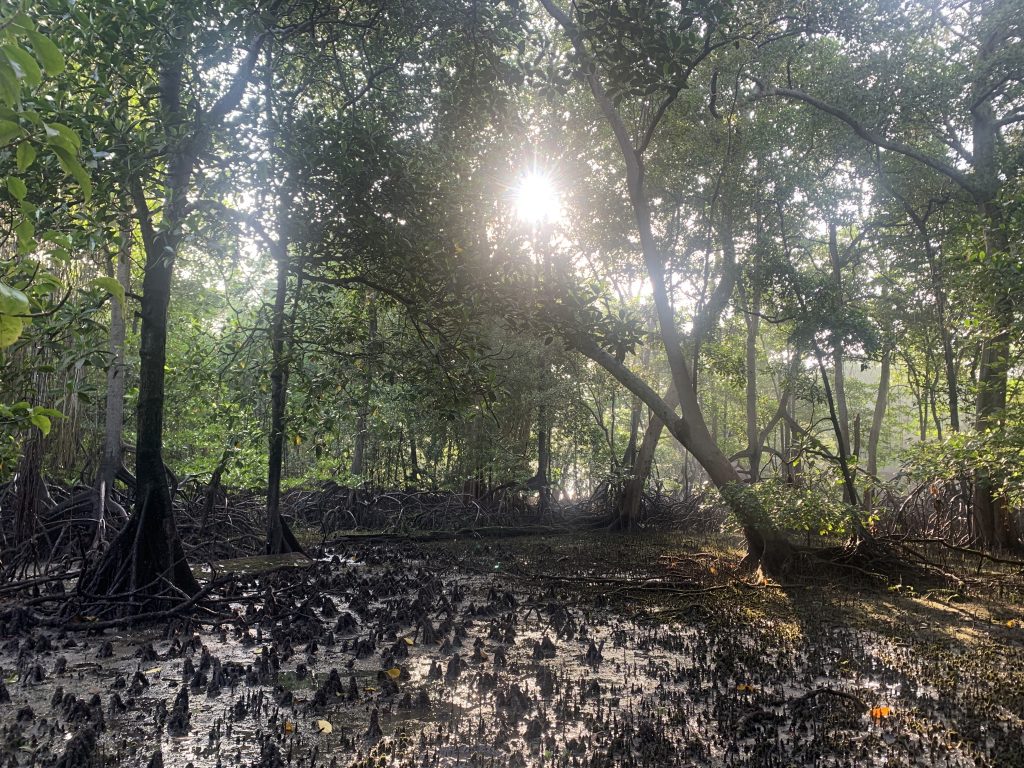Identifying spatial patterns and interactions among multiple ecosystem services in an urban mangrove landscape
July 26, 2021
The International Day for the Conservation of the Mangrove Ecosystem is marked every 26th of July. Adopted by the General Conference of the UN Educational, Scientific and Cultural Organization (UNESCO), it aims to raise awareness of the importance of mangrove forests as unique ecosystems that are important for biodiversity conservation and coastal sustainability, even in urban environments.
Mangrove forests in and around cities (also called urban mangroves) are important for building connections with nature, biodiversity conservation, and coastal sustainability. They are also important sinks of carbon due to their ability to sequester and store substantial amounts of carbon from the atmosphere at rates greater than other ecosystems. Consequently, they have been identified as a key nature-based solution to reduce carbon dioxide from the atmosphere. Urban mangroves also offer potential solutions to current and emerging environmental issues, such as removing pollutants from the air and water, increasing urban liveability. However, unsustainable land-use change and rapid urbanization also threaten the health of mangrove forests, jeopardizing the benefits which people derive from them. In Singapore, rapid urbanisation has reduced the space which mangroves occupy in Singapore’s land area from 13% to a mere 1.1%.
One of the measures the Government of Singapore has taken to address this is establishing the Sungei Buloh Nature Park Network in August 2020. The network will triple the size of the reserve, which was created as a nature park in 1993 and became a nature reserve in 2002. The network includes the Kranji Coastal Nature Park, Kranji Marshes, Kranji Reservoir Park, the Southern Extension, and the Jalan Gemala Marshland and Kranji Reservoir Marshes Nature Areas. In 2022, the Lim Chu Kang Nature Park and Mandai Mangrove and Mudflat Nature Park are slated to be completed and added to the network.
Urban mangroves are important to the wellbeing of people in cities, but as demands for different types and amounts of benefits increase, so does the likelihood of unintended trade-offs. Working to embed ecosystem services into sustainable urban development, Dr Jahson Berhane Alemu (NUS Department of Geography), Dr Daniel Rex Richards (Singapore-ETH Centre), Dr Leon Yan-Feng Gaw (Singapore-ETH Centre), Dr Mahyar Masoudi (NUS Department of Architecture), Mr Yudhishthra Nathan (Singapore-ETH Centre), and Associate Professor Daniel Friess (NUS Department of Geography) propose a multi-functional landscape approach to ecosystem services assessments using the case study of Singapore in ‘Identifying spatial patterns and interactions among multiple ecosystem services in an urban mangrove landscape’ (Ecological Indicators, 2021). Multi-functionality in this case refers to the capacity of an ecosystem to simultaneously produce multiple ecosystem services.
Mangroves are highly multi-functional landscapes, and science that identifies the relationships between ecosystem services productions can support decision-making about trade-offs for conservation, nature-based solutions, restoration, and planned relocation of human and natural infrastructure. Areas of ecosystem service synergy and hotspot overlap represent possible priority areas of future conservation and highlight what might be lost if significant degradation were allowed to occur.
Although mangroves are highly irreplaceable, trade-offs are inevitable in the face of urbanisation. For example, it was found that the strongest trade-off in ecosystem services was between cooling effect and recreational potential. Management strategies are thus integral to reduce the risk of long-term damaging effects on ecosystems and human wellbeing. In particular, regulating services such as water quality and local temperature is critical since these services are produced at local scales and cannot be easily substituted by engineering solutions. The research team also conclude that there is a tendency for larger mangrove patches to support greater ecosystem service supply, and even the smallest mangrove patches may be able to support similar levels of production.
Read the article here.
Learn more about mangrove ecosystem services and their dynamics at the Mangrove Lab.
More information about the Sungei Buloh Nature Park Network can be found here.

